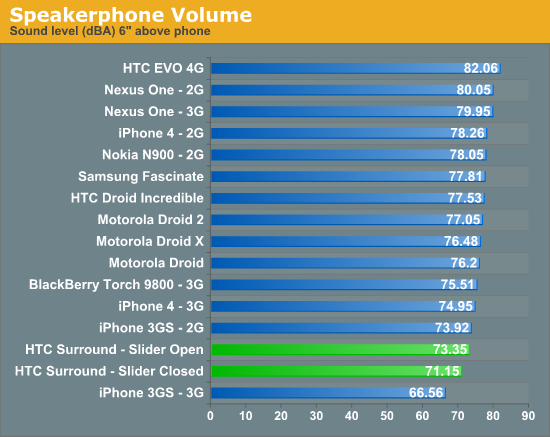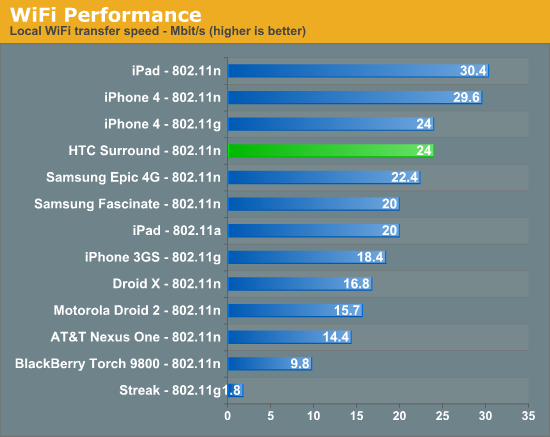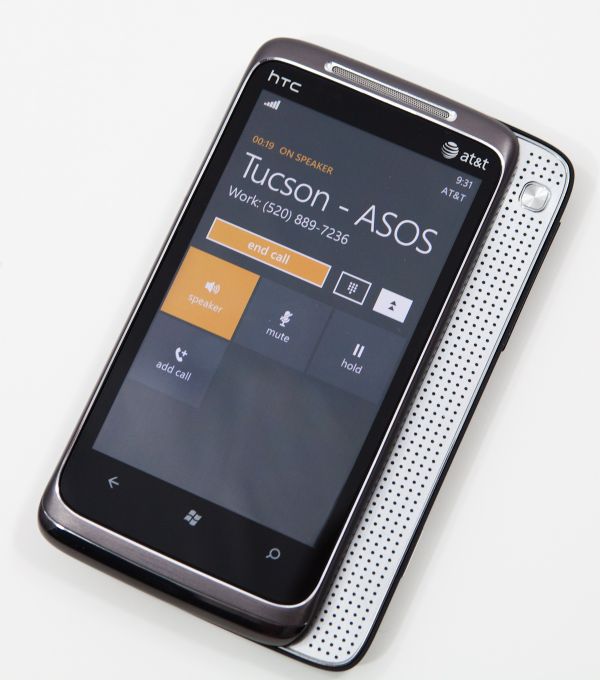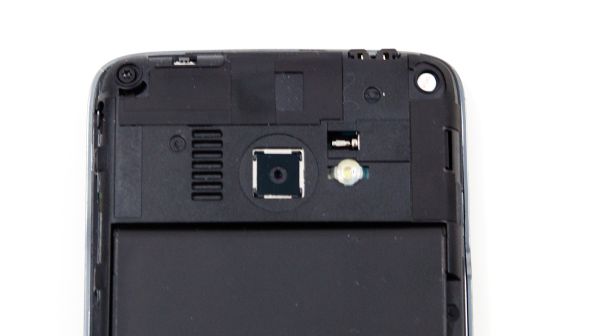HTC Surround Review: A Pocket Boombox
by Brian Klug on November 13, 2010 2:01 AM EST- Posted in
- Smartphones
- Windows Phone 7
- HTC Surround
- Mobile
So what about the speaker but in the context of actually placing calls? Strangely, the loudness story is completely opposite when you're making a call and want speakerphone. The first time I placed a call and turned speakerphone on, I was confused. Audio was muffled and muted, and given the grating on the back, I expected audio be coming out of the back of the device. Then it occurred to me - the speakerphone for calls is the slide out speaker itself.
The problem with this is that every time you want the speakerphone to actually be loud enough to hear, you need to slide it out. Alright, not that big of a deal if it's loud, right?
The problem? It isn’t that loud. In fact, it’s among the quietest I've laid hands on.

I’m at a loss for why the HTC Surround is so quiet in actual calls, considering how loud it is at music and video playback, especially given the fact that we’re using the same speakers. Volume was at maximum, the slider was open, and we were on 3G UMTS for the call like always. The device is just that quiet. Interestingly, none of the audio enhancements do anything when you’re using the speaker in speakerphone mode. Pressing the button results in the same vibration feedback that it always does, but the event does nothing to change the sound output.
Clearly, HTC or WP7 isn’t setting the gain correctly, and the result is the Surround is simply too quiet to be acceptable for speakerphone calls. It's a bitter irony that the smartphone which packs a gigantic speaker that tops our charts for music loudness is so clearly deficient when it comes to actually making speakerphone calls.
Using the handset normally, I found the volume to be just about typical in terms of dynamic range. Call audio quality is subjectively where I’m used to it being - UMTS 3G voice calls honestly sound very good to me, and the Surround didn’t disappoint. I placed some calls on GSM in EDGE territory on AT&T (which is unsurprisingly easy to find, I drove on the I-8 to San Diego and spent the whole time on EDGE) and they sounded good as well. I experienced the same kind of volume level disparity between GSM (2G) and UMTS (3G) calls that I mentioned iOS still has - more dynamic range at work. Again, I’m still working on devising a subjective call quality test - for now all I can say is that calls to all the usual subjects sounded lik they do on numerous other devices I've popped a SIM in.
Antenna
We’ve made a point of testing each and every device for signal attenuation problems, and thus far have been consistent about it. Unfortunately, we’re somewhat reliant on there being a way to read raw signal strength from the baseband to run our tests, and haven’t found a way to do that on WP7 quite yet. It’s still early, and we haven’t done a lot of poking around for dialer codes which will expose a field test program, if WP7 even has one. That said, the HTC Surround does seem to be on par with the vast majority of smartphones in being relatively grip insensitive.
The antenna on the Surround appears to be at the very top, and there's possibly another at the bottom. With the back over off, you can clearly see a black ribbon cable coming from a notch in the plastic cover. Inside are clear outlines from the radiative surface inside the flex cable. There’s a piece of black tape holding the middle in place, and another antenna flex cable on the far right potentially for WiFi or Bluetooth 2.4 GHz radios.
The Surround is only available on AT&T, and as such we see support for AT&T's UMTS bands. The HTC Surround is a tri-band UMTS device, but you do get GSM/EDGE support for other bands as shown below.
| HTC Surround Network Support | |||||
| UMTS | 850 / 1900 / 2100 MHz | ||||
| GSM/EDGE | 850 / 900 / 1800 / 1900 MHz | ||||
| HSDPA/HSUPA | 7.2Mbps / 384Kbps | ||||
WiFi Speed

WiFi transfer speeds I’ve measured are decent at 15.026 megabits/s using our 100 MB test PDF loaded through the browser. I’ve seen sustained connection rates of up to 24 megabits/s when the device is performing wireless sync with Zune, however, which seems more representative. Wireless range on the Surround is actually quite impressive - I can make it all the way to the curb without dropping connection, which is just as far as the best smartphones I’ve tested can go. Similarly, hand-on and hand-off happen without issue. Oh, and WPA2 Enterprise works fine on the HTC Surround, I tested on a WPA2 Enterprise network with all Cisco APs running full 802.1x PEAP with certificates and never experienced a hitch - bravo to WP7 for getting this perfect on the first attempt.
We've also been paying attention to GPS closely ever since the Galaxy S GPS situation - the Surround gets fixes fast and accurately. Whatever Microsoft is using for its location services does a good job getting a rough position indoors, and GPS takes it the rest of the way outdoors just as quickly as I'm used to on other devices.












39 Comments
View All Comments
HobHayward - Saturday, November 13, 2010 - link
It's possible different cell providers include different size microSD cards.Also anandtech's spam filter is trying to not let me post this.
Anand Lal Shimpi - Saturday, November 13, 2010 - link
You are correct, fixed :)Take care,
Anand
deputc26 - Saturday, November 13, 2010 - link
I'd like to see this metric included:http://lovinitinaz.blogspot.com/2010/11/new-metric...
Meegulthwarp - Saturday, November 13, 2010 - link
I'd really like to see a comparison of the speeds the different class cards give. If installing a class 6 or 10 card vastly improves the performance of the device then I would gladly replace it but if it is only for bigger GBs then I'll pass as I'm quite happy with 8GB right now.Orange UK has an option to buy a 16GB card when you are purchasing a HTC Mozart online. Not sure what that's about as the cards aren't user replacable, might phone them up later on to ask.
bigboxes - Saturday, November 13, 2010 - link
that needs to use their headphones.*seated at the restaurant next to boxes*
OMG! Listen to this!
*giggle*
Let's play it again, but this time turn it up louder!
*boxes picks up teen's cell phone and smashes it into restaurant wall*
This is not going to replace larger sets at home and on the road (on the bus, in the grocery store line, at the restaurant, etc.) you should use headphones.
kevith - Saturday, November 13, 2010 - link
Oh yes, in my country this is already quite trendy among teenagers. It can be realyy annoying.Seems like an ok phone though, still I think we´ve only seen the beginning. As before with first desktops, then laptops, the whole race for Mhz and faster hardware can start all over again in a new formfactor, The Pockettop...
I´m 50 years old, it´s great to have lived half my life before computers entered the scen for home-users. I´m a muscician, and when I think of the things we used to dream, that computers would be able to, and what they actually are capable of today, I feel a little bit as if had been wittnessing the Wright Bros first attempts to fly.
And now - well, in a short time anyway - maybe a studio-PC to carry in your pocket.
Wonderful.
Nataku - Monday, November 15, 2010 - link
i can see some use for this though, not that i want some jerk cranking it up in a bus full of already pissed off people... lol(kids learning to dance during break time some where down the hall might be one good application for this)
NYHoustonman - Saturday, November 13, 2010 - link
What the hell is that noise D:banvetor - Saturday, November 13, 2010 - link
Dear Anand and Brian,Thank-you for the excellent phone reviews you are making. I wish to ask one thing though: in your reviews, can you make some points about the usability of each OS when you DO NOT have a data plan?
I don't know how many of us are out there, but I use a lot my smartphone (music, taking pictures, gps, etc), but I simply have no need for a many-dollar-a-month data plan. I do browse the web and check e-mails also, but only when there is wi-fi... If I have some VERY IMPORTANT e-mail to check, then I pay for the KB of data...
The most important points would be how dependent on a always-on data connection the OSes are... like the Zune music access, for instance. I have a Nokia N96 right now (planning to switch soon), and I just love that it has a map application that works offline, for instance (I know that no other phone has that, but I highlighted it just to make my point...).
Thanks once again!
Leo.
Gungel - Sunday, November 14, 2010 - link
With AT&T you have to get a data plan on your smartphone. Even if you buy a phone off contract, they will add a dataplan once the network checks your IMEI and recognizes it as such. I was on an old $15 a month unlimited data plan grandfathered in when SBC became AT&T. I recently bought an Android phone off contract and got a nice surprise on my next phone bill. The data plan is now $30 and is limited to 2GB a month.